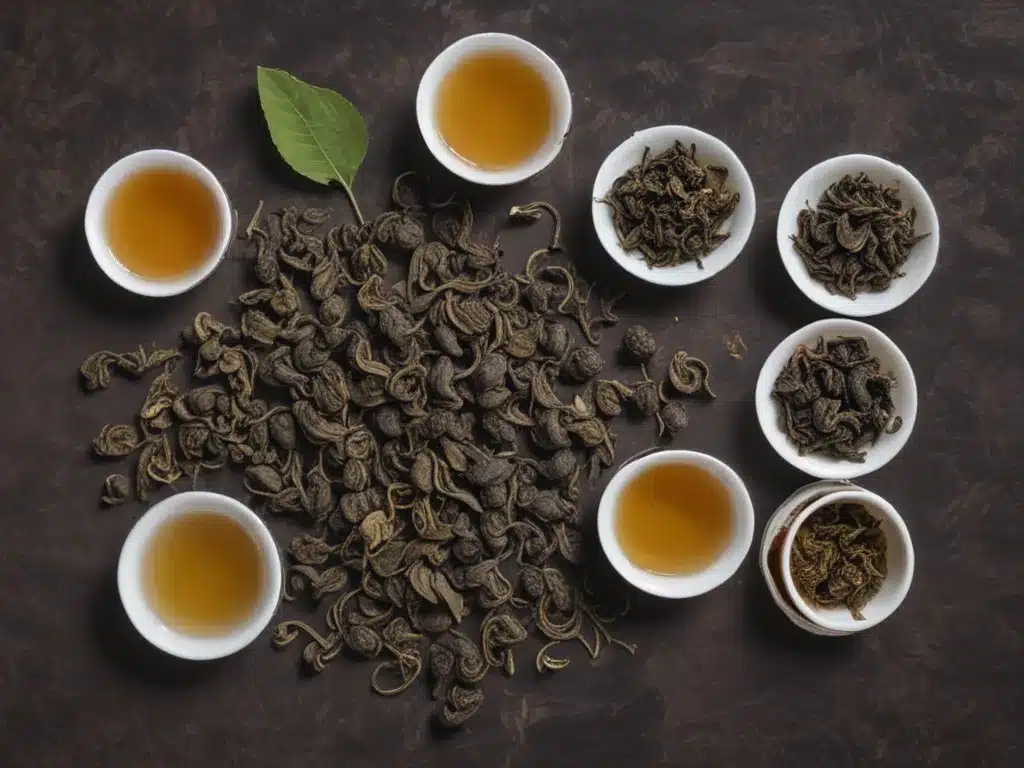
The Intriguing World of Oolong Tea
As an avid tea drinker, I am always seeking new teas to explore in hopes of discovering nuanced flavors and exceptional brews. Recently, my curiosity has led me to the world of oolong tea, a style that has captivated me with its complexity. Oolong tea is produced through a unique withering and oxidation process that renders it neither entirely green nor black, but rather somewhere in between. This intermediate oxidation allows for a diversity of aromas and tastes within the oolong varietals.
In this article, I aim to delve deeper into understanding oolong tea by exploring its production method, common types, flavor profiles, and ideal brewing techniques. My goal is to convey my appreciation for the subtlety and sophistication of this intriguing tea. Perhaps by learning more about what makes oolong tea special, other tea lovers may be inspired to explore its nuanced flavors for themselves.
The Fascinating Process of Creating Oolong Tea
The craft of producing oolong tea starts in the tea fields, where master tea makers carefully handle the fresh tea leaves. After harvesting, the leaves are withered under the sun or indoors using hot air to reduce their moisture content. This initiates the enzymatic oxidation process.
During withering, the tea leaves are shaken in large bamboo baskets or flat woven trays to prevent clumping. The extent and uniformity of withering is crucial, as it determines how much airflow reaches the leaves during the subsequent processing stages. Improperly withered leaves may not oxidize evenly.
Once withered, the leaves undergo a periodic twisting and folding process known as “loose rolling.” This stage exposes more of the interior leaf to oxygen in the air, allowing a controlled amount of oxidation to take place. Skilled tea makers gently squeeze, roll, unfold and spread the leaves numerous times over several hours to curate the desired color, aroma, and taste.
The leaves are then fired in hot pans or baked to halt further oxidation. The resultant oolong tea may be light brown like the Da Hong Pao varietal or dark enough to pass for a black tea. In any case, the artisanal process lends oolong teas their signature complexity through modulation of leaf enzymes and phenolic compounds.
Common Oolong Varietals from Around the World
Just as varietals define the taste of grapes in wine, the region and cultivar of tea profoundly shape its characteristics. Some popular oolong types originating from different parts of Asia include:
Chinese Oolongs
-
Da Hong Pao (Big Red Robe) from Wuyi Mountains: Considered the “king” of oolong teas, it has a rich, orchid-like fragrance and roasted nuts flavor.
-
Tie Guan Yin from Anxi, Fujian: Named after the Buddhist Goddess of Mercy, it has a delicate floral aroma and mellow taste.
Taiwanese Oolongs
-
Da Yu Ling from Alishan: Its toasted corn and honey flavors make it a crowd favorite.
-
Ji Guan Yin from Lugu: Featuring a lush, honeyed sweetness and hint of toasted nuts.
Other Varietals
-
Bali Oolong from Indonesia: Reminiscent of apples and oranges with a crispy texture.
-
Sweet Ma Long from Yunnan, China: Mildly oxidized with light caramel notes.
The region’s soil, climate and artisanal methods impart each oolong type its own distinctive personality worth exploring. Comparing varietals side-by-side reveals subtle flavor nuances within this wide-spanning class of tea.
Brewing Oolong Tea to Unlock its Complex Flavor
To fully appreciate an oolong tea’s complexity, one must brew it optimally using the right temperature and steeping time. As a rule, the lighter and more aromatic the oolong variety, the lower the recommended water temperature. Meanwhile, darker oolongs tolerate higher heat.
As a starting point, I find the following brewing guidelines work well for versatile oolong teas:
| Tea Type | Water Temperature | Steeping Time |
|---|---|---|
| Light, aromatic oolongs | 160-175°F (70-80°C) | 1-2 minutes |
| Medium oolongs | 175-185°F (80-85°C) | 1.5-3 minutes |
| Robust, full-bodied oolongs | 185-200°F (85-93°C) | 2-4 minutes |
It is also important to use the right leaf-to-water ratio based on preference, with 1-2 grams of tea per 6-8 ounces of water being typical. Multiple short steepings, ideally with freshly heated water each time, allow oolong flavors to gradually unfold in layers. With practice perfecting the brewing technique, one can truly unlock an oolong tea’s complex flavor profile.
Seeking out Oolong Tea’s Sophistication
In concluding this exploration of oolong tea, I am left with an even deeper respect for its sophistication. The intermediate oxidation level during production lends oolongs a signature complexity, yielding an array of taste experiences between green and black teas. Subtle variances in cultivar, processing and brewing further diversify the profile.
Discovering new oolong types has become one of my favorite pastimes, whether trying delicately floral Taiwanese Da Yu Ling or richly mineral Wuyi Da Hong Pao. I appreciate how each brew reveals something new with every sip. The nuanced flavors remind me to slow down and truly savor life’s subtle moments. Going forward, I aim to continue my oolong journey – may it guide me ever deeper into tasting complexity and mindfulness.






